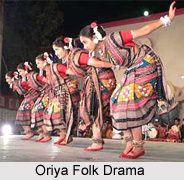 Rahasa is a variety of Raslila in musical dance-drama form mostly confined to the coastal districts of Puri and Cuttack in Orissa. Many Rahasa scripts were written by Vaishnava poets as Basanta or spring rahasa and Sarat or autumn rahasa. Rahasa is very popular for over a century. It is performed both by amateurs and professionals, by young boys and girls. The duration depends on the number of episodes. In some villages it is held for more than a week by amateur artists of the village. The performance includes elaborate singing with gestures and mild dancing. The most popular and important contributors to Rahasa were Mohansundar Deva Goswami, Govinda Chandra Surdeo, Bhakta Charan Das, and Kali Charan Patnaik. They toured all over Orissa with their professional troupes till the early 1940s. The famous Odissi dance guru Kelucharan Mahapatra initially belonged to Goswami`s excellent group.
Rahasa is a variety of Raslila in musical dance-drama form mostly confined to the coastal districts of Puri and Cuttack in Orissa. Many Rahasa scripts were written by Vaishnava poets as Basanta or spring rahasa and Sarat or autumn rahasa. Rahasa is very popular for over a century. It is performed both by amateurs and professionals, by young boys and girls. The duration depends on the number of episodes. In some villages it is held for more than a week by amateur artists of the village. The performance includes elaborate singing with gestures and mild dancing. The most popular and important contributors to Rahasa were Mohansundar Deva Goswami, Govinda Chandra Surdeo, Bhakta Charan Das, and Kali Charan Patnaik. They toured all over Orissa with their professional troupes till the early 1940s. The famous Odissi dance guru Kelucharan Mahapatra initially belonged to Goswami`s excellent group.
Radhaprem Lila is another form of Raslila that is prevalent in the southern district of Ganjam. Radhaprem Lila is literally known as `Radha`s Love Play. Written and started by Pitambar Rajendra in the late nineteenth century, it is performed in front of a kunja or bower built with wood and beautifully painted with floral designs. Radha and her companions, the Sakhis, sit there while Krishna comes in different disguises to meet her. Though fully operatic it has various acrobatic dance sequences. Both styles of Rahasa use classical Odissi dance and music.
This article is a stub. You can enrich by adding more information to it. Send your Write Up to content@indianetzone.com




















